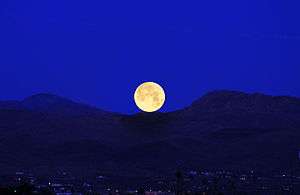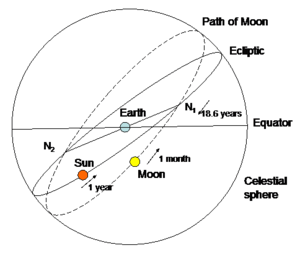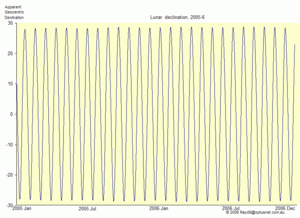Lunar standstill
At a major lunar standstill, which takes place every 18.6 years, the declination range of the Moon reaches a maximum. As a result, viewed from high latitudes, the Moon's greatest altitude (at culmination, when it contacts the meridian) changes in just two weeks – from high in the sky to low over the horizon.
This time appears to have had special significance for the Bronze Age societies who built the megalithic monuments in Britain and Ireland, and it also has significance for some neopagan religions. Evidence also exists that alignments to the moonrise or moonset on the days of lunar standstills can be found in ancient sites of other ancient cultures, such as at Chimney Rock in Colorado and Hopewell Sites in Ohio.
Origin of name
The term "lunar standstill" was apparently first used by archeologist Alexander Thom in his 1971 book "Megalithic Lunar Observatories".[1] The term "solstice", which derives from the Latin solstitium: sol- (sun) + -stitium (a stoppage), describes the similar extremes in the sun's varying declination. Neither the sun nor the moon stands still, obviously; what stops, momentarily, is the change in declination. The word "tropic", as in Tropic of Capricorn, comes from ancient Greek meaning "to turn", referring to how ascending (or descending) motion turns to descending (or ascending) motion at the solstice.[2]
Informal explanation
As the Earth spins on its axis, the stars above us appear to move in circles. It appears to us as if all the stars are fixed in a great sphere surrounding us. In the same way that we measure positions on the Earth using latitude and longitude, we measure positions of stars on this sphere in right ascension (equivalent to longitude) and declination (equivalent to latitude). Viewed from a place on the Earth which has latitude 50°, then the stars directly above have a declination of 50°.
Unlike the stars, the Sun and Moon do not have a fixed declination. As the Earth travels its annual orbit around the Sun, with its rotational axis tilted at about 23.5° from a line perpendicular to the plane of the orbit, the Sun's declination changes from +23.5° at the northern hemisphere Summer Solstice to −23.5° at the northern hemisphere Winter Solstice. Thus, in the northern hemisphere, the Sun is higher in the sky and visible for a longer period of time in June than it is in December. This is the cause of the Earth's seasons.
The Moon also changes in declination, but it does so every lunar nodal period or 27.212 days. So it goes from a positive declination to a negative one in under two weeks. Thus, in under a month the Moon's altitude at its culmination (when it is due south on the meridian) can move from being high in the sky, to low over the horizon, and back again.
The Moon's maximum and minimum declination also vary because the plane of the Moon's orbit around the Earth is inclined by about 5.14° to the ecliptic (the plane of the Earth's orbit around the Sun), and the direction of lunar orbit inclination gradually changes over an 18.6-year cycle, alternately adding to or subtracting from the 23.5° tilt of the Earth's axis. As a consequence, the maximum declination of the Moon varies from roughly (23.5° − 5° =) 18.5° to (23.5° + 5° =) 28.5°. As a result, at minor lunar standstill, the Moon will change its declination during the nodal period from +18.5° to −18.5°, which is a total movement of 37°. Then, 9.3 years later, during the major lunar standstill, the Moon will change its declination during the nodal period from +28.5° to −28.5°, which is a total movement of 57°, which is enough to take its culmination from high in the sky to low on the horizon in just two weeks (half an orbit).
Strictly speaking, the lunar standstill is a position in relation to the motion of lunar orbit turning in fixed space: it does not persist over the two weeks that the Moon takes to move from its maximum (positive) declination to minimum (negative) declination, and it most likely will not exactly coincide with either extreme. However, because the 18.6-year cycle of standstills is so much longer than the Moon's orbital period, the change in the declination range over periods as short as half an orbit is very small. The period of lunar orbit turning in space is slightly shorter than the lunar standstill interval due to precession altering the inclination of earth rotation over a very long period relative to the moon's orbit rotating direction. Simply, the standstill cycle results from the combination of the two inclinations.
Direction of moonrise and moonset and altitude of moon at culmination
The azimuth (direction) of moonrise and moonset varies according to the moon's nodal period of 27.212 days while the azimuth variation during each nodal period varies with the lunar standstill period (18.613 years). For a northern latitude on earth of 55° the following table shows moonrise and moonset azimuths for the moon's narrowest and widest arcs across the sky. The azimuths are given in degrees from true north and apply when the horizon is unobstructed. Figures for a time midway between major and minor standstill are also given. Widest arc for full moon is generally achieved at midwinter and narrowest at midsummer. For new moon (when it near the sun in the sky) widest arc is in the summer, as for the sun.[3]

Azimuth of full moon on horizon narrowest arc widest arc epoch moonrise moonset moonrise moonset minor standstill 124° 236° 56° 304° midway 135° 225° 45° 315° major standstill 148° 212° 32° 328°
For observers at latitudes not too close to the equator or a pole, the Moon is highest in the sky in each period of 24 hours when it culminates on crossing the observer's meridian. During the month, these culmination altitudes vary so as to produce a greatest value and a least value. The following table shows these altitudes at different times in the lunar nodal period for an observer at 55° latitude. The greatest and least culminations occur about two weeks apart.
Altitude at culmination epoch greatest least minor standstill 53.5° 16.5° midway 58.5° 11.5° major standstill 63.5° 6.5°
The following table shows some occasions of a lunar standstill. The times given are for when the moon's node passed the equinox—the moon's greatest declination occurs within a few months of these times, depending on its detailed orbit.[4][5] However, the phenomenon is observable for a year or so on either side of these dates.[1]
Detailed explanation

A more detailed explanation is best considered in terms of the path of the Sun and Moon on the celestial sphere, as shown in the first diagram. This shows the imaginary sphere of the sky, surrounding the Earth at the center. The Earth is aligned so that the Earth's North Pole is pointing straight up.
The Sun is, by definition, always seen on the Ecliptic: the sun's apparent path across they sky, while the earth is tilted at an angle of e = 23.5° to the plane of that path, and completes one revolution around the Earth in 365.25636 days, slightly longer than one year due to precession altering the direction of earth's inclination.
The Moon's orbit of the earth (shown dotted) is inclined at an angle of i = 5.14° in relation to the ecliptic. The Moon completes one revolution around the Earth in 27.32166 days. The two points at which Moon crosses the ecliptic are known as the nodes, shown as N1 and N2, and the line connecting them is known as the line of nodes. Due to precession of lunar orbit inclination, these crossing points, the nodes and the positions of eclipses, slowly move around the ecliptic in a period of 18.59992 years.
Looking at the diagram, note that when the Moon's line of nodes (N1 & N2) rotates a little more than shown, and aligns with the Earth's equator, (from front to back, N1, Earth, and N2, seem to be the same dot), the Moon's orbit will reach its steepest angle with the Earth's equator, and in 9.3 years (from front to back, N2, Earth, N1 seem to be the same dot) it will be the shallowest: the 5.14° declination (tilt) of the Moon's orbit either adds to (major standstill) or subtracts from (minor standstill) the inclination of earth's rotation axis (23.439 degrees).

The effect of this on the declination of the Moon is shown in the second diagram. During the course of the nodal period, as the Moon orbits the Earth, its declination swings from –m° to +m°, where m is a number in the range (e – i) ≤ m ≤ (e + i). At a minor standstill (e.g., in 2015), its declination during the month varies from –(e – i) = –18.5° to +(e – i) = 18.5°. During a major standstill (e.g., in 2005-2006), the declination of the Moon varied during each month from about –(e + i) = –28.5° to +(e + i) = 28.5°.

However, an additional subtlety further complicates the picture. The Sun's gravitational attraction on the Moon pulls it toward the plane of the ecliptic, causing a slight wobble of about 9 arcmin within a 6-month period. In 2006, the effect of this was that, although the 18.6-year maximum occurred in June, the maximum declination of the Moon was not in June but in September, as shown in the third diagram.
Other complications
Because the Moon is relatively close to the Earth, lunar parallax alters declination up to 0.95° when observed from Earth's surface versus geocentric declination, the declination of the Moon from the center of the Earth. Geocentric declination may be up to about 0.95° different from the observed declination. The amount of this parallax varies with latitude, hence the observed maximum of each standstill cycle varies according to position of observation.
Atmospheric refraction - the bending of the light from the Moon as it passes through the Earth's atmosphere - alters the observed declination of the Moon, more so at low elevation where the atmosphere is thicker (deeper).
Not all the maxima are observable from all places in the world - the Moon may be below the horizon at a particular observing site during the maximum, and by the time it rises it may have a lower declination than an observable maximum at some other date.
2006 standstill
| Events in Sydney, Australia | Date / Time | RA | Dec | Az. | Elev | Lunar phase |
|---|---|---|---|---|---|---|
| Closest viewing of "true maximum" on 15 September during civil twilight | 14 September 19:53 | 04:42:57.32 | +29:29:22.9 | 3 | 27 | 46% waning |
| Highest visible maximum during civil twilight | 4 April 07:49 | 06:03:11.66 | +29:30:34.5 | 350 | 26 | 38% waxing |
| Highest visible maximum during darkness | 4 April 09:10 | 06:05:22.02 | +29:27:29.4 | 332 | 21 | 39% waxing |
| Lowest visible minimum during civil twilight | 22 March 19:45 | 18:10:57.40 | −28:37:33.2 | 41 | 83 | 50% waning |
| Lowest visible minimum during darkness | 22 March 18:36 | 18:09:01.55 | −28:36:29.7 | 80 | 71 | 50% waning |
| Events in London, England | Date/Time | RA | Dec | Az. | Elev | Lunar phase |
| Highest visible maximum during civil twilight | 15 September 05:30 | 06:07:12.72 | +28:19:52.6 | 150 | 64 | 42% waning |
| Highest visible maximum during darkness | 7 March 19:43 | 05:52:33.05 | +28:18:26.9 | 207 | 64 | 60% waxing |
| Lowest visible minimum during civil twilight | 29 September 17:44 | 17:49:08.71 | −29:31:34.4 | 186 | 9 | 43% waxing |
| Lowest visible minimum during darkness | 2 September 20:50 | 18:15:08.74 | −29:25:44.0 | 198 | 7 | 70% waxing |
Note that all dates and times in this section, and in the table, are in UTC, all celestial positions are in topocentric apparent coordinates, including the effects of parallax and refraction, and the lunar phase is shown as the fraction of the Moon's disc which is illuminated.
In 2006, the minimum lunar declination, as seen from the centre of the Earth, was at 16:54 UTC on 22 March, when the Moon reached an apparent declination of -28:43:23.3. The next two best contenders were 20:33 on 29 September, at a declination of -28:42:38.3 and 13:12 on 2 September at declination −28:42:16.0.
The maximum lunar declination, as seen from the centre of the Earth, was at 01:26 on 15 September, when the declination reached +28:43:21.6. The next highest was at 07:36 on 4 April, when it reaches +28:42:53.9
However, these dates and times do not represent the maxima and minima for observers on the Earth's surface.
For example, after taking refraction and parallax into account, the observed maximum on 15 September in Sydney, Australia was some hours earlier, and then occurred in daylight. The table on the right shows the major standstills that were actually visible (i.e. not in full daylight, and with the moon above the horizon) from both London, UK, or Sydney, Australia.
For other places on the Earth's surface, positions of the Moon can be calculated using the JPL ephemeris calculator.
References
- 1 2 Vincent, Fiona (2005). "A major ‘lunar standstill’" (PDF). Journal of the British Astronomical Association. 115 (4): 220. Bibcode:2005JBAA..115..220V. Retrieved 14 January 2012.
- ↑ Dictionary.com – tropic.
- ↑ Burl, Aubrey (1995). A Guide to the Stone Circles of Britain, Ireland and Brittany. Yale University Press. pp. 19–20. ISBN 9780300063318.
- ↑ Vincent, Fiona. "Lunar standstills". What's in the sky?. Archived from the original on 14 January 2012.
- ↑ Vincent, Fiona. "More about lunar standstills". What's in the sky?. Archived from the original on 14 January 2012.
- 1 2 3 Times of maxima and minima of lunar declination at culmination "Solar System Dynamics". Horizons. NASA Jet Propulsion Laboratory.
External links
- Major Lunar Standstill 2006 A photographic digital mosaic of the 2006 event from Greece
- Lunar Standstill Season
- A webcamera at Calanais I (Lewis, Scotland) recording the lunar standstill events in 2005, 2006 and 2007
- A project to study the major standstill events in 2005, 2006 and 2007 at (pre-)historic buildings
- Major Lunar Standstill at Chimney Rock